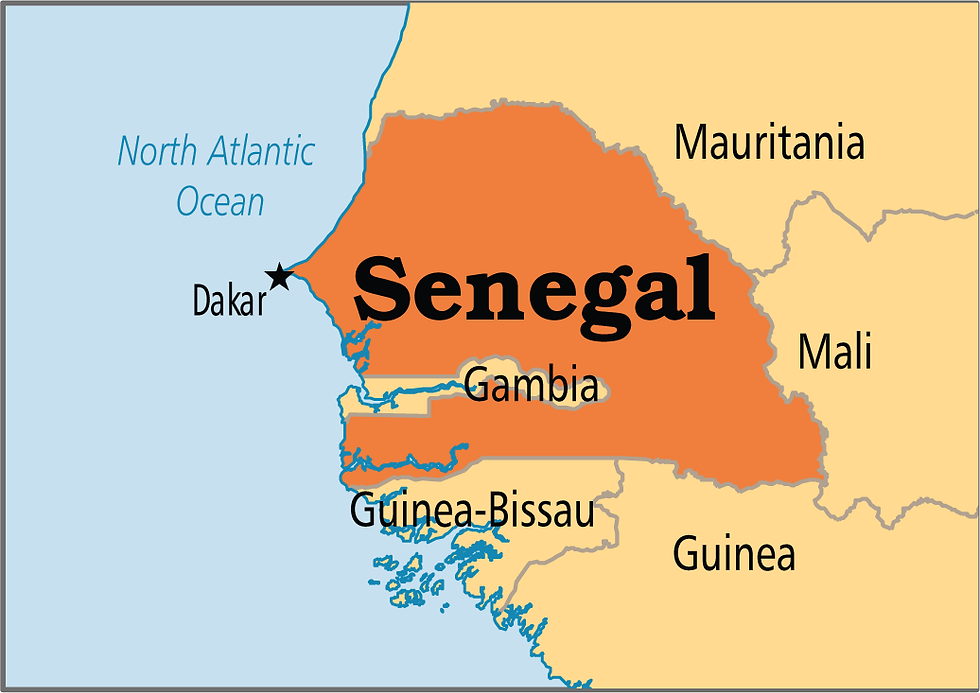Senegal
- To-Go

- Apr 30, 2022
- 3 min read
Updated: Sep 16, 2022
Country Name
Senegal, or officially the Republic of Senegal.
Location
Senegal is located in West Africa. Senegal is bordered by Mauritania in the north, Mali to the east, Guinea to the southeast, and Guinea-Bissau to the southwest. It also nearly surrounds The Gambia. Also, Senegal shares a maritime border with Cape Verde.

Capital
Dakar.
The reason for naming the country
"Senegal" probably derives from a Portuguese transliteration of the name of the Zenaga, also known as the Sanhaja, the word "gal" meaning the body of water in the Serer language. Alternatively, the name could derive from the Wolof word "Sunuu Gaal," which means "our boat."
Flag
The flag of Senegal was adopted on August 20, 1960, after gaining independence.
The flag consists of three vertical stripes green, yellow, and red colors.
In the middle of the yellow stripe, there is a green five-pointed star is located. The colors are typical pan-African, where green represents the rich
nature of the country as well as the Muslim religion, yellow represents sunshine, arts, and welfare, and red represents the bloodshed in the struggles for independence of the country.
The green star represents Islam and Prophet Mohamed (PBUH).
* Flag Facts:
-The flag of Mali and the flag of Senegal have very similar flags. Look for Senegal's central green star to differentiate the two.
- Guinea's flag is also very similar, although the colors are in reverse order.

Language
French is the official language. French is used by the government to make public announcements and is the language of instruction in public schools.
A number of other languages enjoy government recognition as national languages, which means that a particular language may be used by a wide range of individuals. This use is usually designated to a particular region or group of people. The national languages of Senegal include Wolof, Pulaar, Mandinka, Balanta-Ganja, Mandjak, Hassaniya Arabic, Noon, Jola-Fonyi, Serer, Soninke, and Mankanya. Of these national languages, Wolof is the most widely spoken. There are also minority languages such as Portuguese
Religion
Senegal is a secular state, although Islam is the predominant religion in the country, Most of the Senegalese population is made up of Muslims who practice Sunni Islam which is based on Sunni of the Maliki school with Sufi influences. There are a few numbers of populations that adhere to Christianity.
There are also small members of the Serer religion Buddhism, Jews, and Bahai Faith followers.
Currency
West African CFA franc (XOF).

Time Zone
+00:00 GMT.
Government Regime
Unitary presidential republic.
Climate
The climate of Senegal is tropical, with a long dry season that runs roughly from mid-October to mid-June in the north, from early November to mid-May in the south, and a rainy season approximately, from late June to early October in the north, and from late May to late October in the south due to the African monsoon. In the coolest months, December and January, the daytime temperature range between 32 °C and 34 °C in inland areas, while it is a bit less hot on the coast and much cooler in Dakar, around 25 °C. Sometimes, it can get a bit cool at night across the country, with temperatures below 15 °C, while at other times, it can get very hot during the day, with highs around 35 °C in Dakar and 40 °C in the interior. By February, the temperature begins to rise, and reaches its highest levels from April to early June, before the arrival of the monsoon. In the interior, highs are normally around 38 °C in the south and 40 °C in the north, while the coast is definitely more temperate, especially in Dakar, where the average maximum is still around 26 °C in May. Heat spikes are noticeable: around 45 °C in inland areas and up to 47/48 °C in the northeast.
The best time to visit Senegal is winter, from December to mid-February: it's warm on the coast, even hot in the interior, the sun shines, and it practically never rains.












Comments